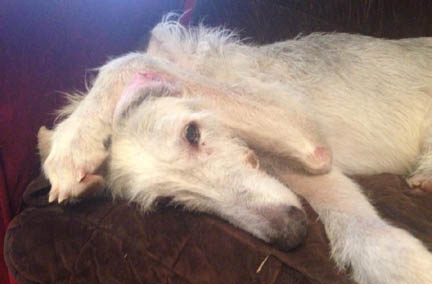Spring is in the air and, as usual, severe weather came with it. Tornadoes have recently turned deadly in the Midwest and destroyed homes, lives and communities. Do you know what to do if tornadoes are forecast in your area? Here are some specific tips from our friends at the Greyhound Adoption League of Texas (who are in a position to know a thing or two about tornadoes).
The National Weather Service can help you decide where to go for safety in a tornado. If the safest place is a community shelter, check its pet policies in advance. Once you know where to go, practice getting there with your pets. Many pets fear wind and thunder, making obstacles such as steep stairs or confined spaces even more challenging. Practice will make you and your pet more confident so that everyone can get to safety as quickly as possible under pressure.
Download a weather app to your mobile devices that will alert you to weather warnings for your area. Review your “lights out” emergency equipment and consider including an emergency mobile phone charger. Keep in mind that, if you need food and water, so will your pets. Stock up on kibble and bottled water such that you have enough to last several days. Spring is the wrong time to procrastinate grocery shopping. The last thing you want is to run out of Toto’s favorite chicken stew the night an F5 tornado visits the grocery store.
If your pet requires a special diet or medications, have plenty on hand by refilling pet prescriptions sooner. Insurance companies control when humans can refill. But usually they are not in the loop on pet prescriptions, so you have more flexibility. If your pet has complicated medical needs, consider talking with your vet about a disaster preparation plan.

Make sure your “bunker” will be sufficiently comfortable and support all biological functions for several hours, even overnight. Keep a spare pet bed, some puppy pads and some poop bags handy. And before letting your pup enjoy the long awaited relief of the back yard, pause a moment to make sure that the fence hasn’t blown down and that broken glass and live electric wires aren’t littering your lawn. Better a little pee on the floor than a loose, scared dog.
If you have a pet that is fearful in bad weather, consider stocking your bunker with a Thunder Shirt or (with your vet’s guidance) herbal remedies such as Rescue Remedy. Some dogs need to be leashed so that you can keep them within your safe area (and your safe area might lose a wall). A hidey hole like a crate can be comforting and can keep your pet from getting away from your safe spot. If you have extra space under your stairs, Toto might really appreciate a built in dog house that he can turn to for quiet safety, even if you’re not home.
Severe weather despises convenience and will almost certainly strike one day when you’re at work. Give some thought to whether a responsible adult can return home to care for the pets. If that isn’t possible, talk to a neighbor who is retired or works from home about whether they can help get your pets to safety. Make sure you know the forecast before leaving for work so that you can make any possible arrangements. Kitties can often spend a day in an interior bathroom or perhaps you can plan to make it a short day and bring work home.
Talk with your family about a meet up location in case your neighborhood is evacuated and the family isn’t together. Mobile phones might not be working, so everyone needs to know the plan in advance. Hotels will sometimes bend pet rules temporarily. But keep a short list of friends with fenced yards that might be in a position to help, even if only for a day or a few hours. Know what you need to take with so you can move quickly - pet meds, beds, food, bowls, etc. Consider whether all your pets will be ok in the car together. These might be circumstances where you need a muzzle to keep the cats and bunnies safe. And if any of your pets have issues getting into a car quickly under pressure, address them now with training.
AND THE MOST IMPORTANT THING OF ALL: Make sure your pets have current identification tags and that your microchip contact info is current so that you can be reunited if separated in the chaos. Stay safe everyone!
You can see the original GALT blog post here.

